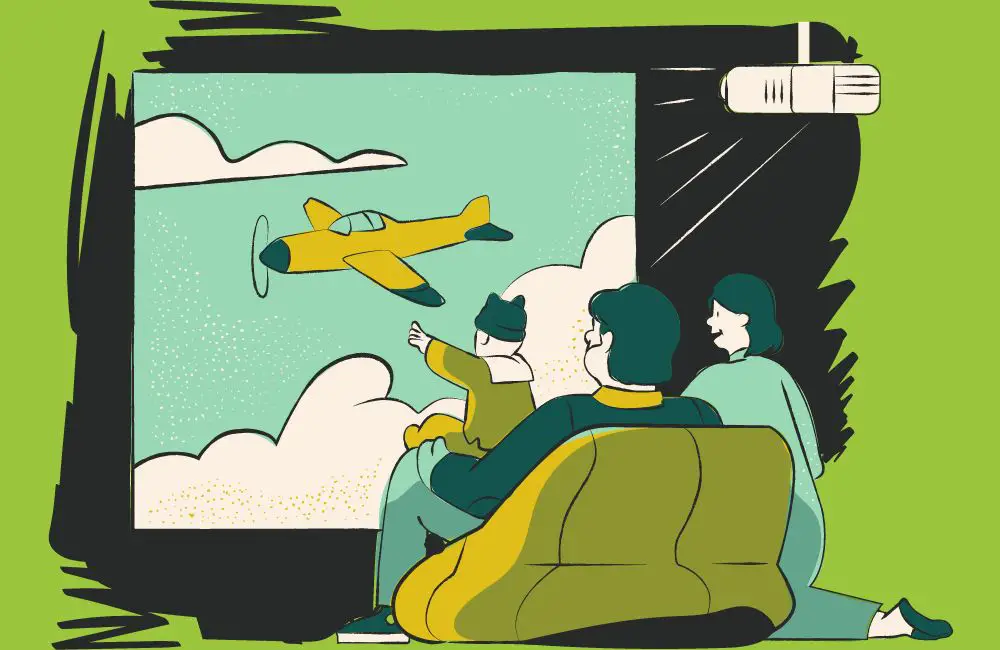Have you ever wondered if watching English movies can help improve your English skills? Well, it can! Movies are fun to watch and a great way to learn everyday English. Let’s explore how this works.
Watching movies can significantly help improve your English. Movies offer authentic, everyday English dialogues, foster listening skills, and provide cultural insights. They also serve as a source of visual context, entertaining education, and repeated language exposure.
For an in-depth understanding of how movies can enhance your English skills, continue reading. I’ll share practical steps to maximize your learning experience through watching movies.
Table of Contents
- Movies as a Gateway to Real English
- Deep Dive into the Culture
- Engaging Method of Learning
- Practical Steps to Learn English through Movies
- In Conclusion
Movies as a Gateway to Real English
The question has often popped up: how can I improve my English skills engagingly and effectively? The answer came in an unexpected form: movies. It’s a common leisure activity for most of us, but movies can become a powerful language-learning tool when used deliberately.
They serve as an open door into real, conversational English, far beyond the confines of textbook language. Movies expose us to the authentic usage of the English language in all its varied forms, from daily-life dialogues to the fine nuances of different accents.
1. Real-life Dialogues
Movies are a treasure trove of authentic, everyday English dialogues. These aren’t the scripted conversations you find in textbooks; they’re rich, dynamic, and alive with the nuances of the language. In this subsection, we’ll explore how movies serve as an invaluable resource for understanding how English is spoken and used in various real-life contexts and how they provide a valuable tool for enhancing your contextual understanding of the language.
A Wealth of Linguistic Diversity
English in movies is alive and dynamic, unlike the relatively static language of textbooks. It’s a language of the people, used in their everyday lives, covering an impressive range of topics and situations. While watching movies, I noticed they are abundant in slang, idioms, and colloquial expressions.
Movies expose me to phrases used in various contexts, such as a friendly chat, an intense argument, or a passionate declaration of love. This variety has helped me comprehend how English is used in real-life situations, making my own use of the language more authentic and relatable.
Contextual Understanding
When we read sentences in textbooks, we often lack the accompanying context, which can make the learning process rather abstract. In contrast, movies provide a rich contextual background for every dialogue.
Characters’ reactions, the surrounding environment, the tone of voice – all these factors contribute to a better understanding of the meaning and usage of certain phrases or words. Thanks to movies, I’ve been able to improve my ability to use English appropriately according to different contexts.
2. Listening Skills
Developing your listening ability is one of the most critical skills when learning a new language. This involves not only understanding the words spoken but also tuning in to the language’s accents, pronunciation, pace, and rhythm. In this subsection, we’ll delve into how movies can help improve your listening skills and deepen your understanding of the various aspects of spoken English.
Tuning In to the Sound of English
Movies provide an immersive audio-visual experience, which has been instrumental in enhancing my listening skills. As I watch movies, I’m engrossed by the plot and the characters and the variety of sounds that make up the English language. I’ve found that my understanding of spoken English has significantly improved through this exposure.
Accent and Pronunciation
One of the major benefits of watching movies is the opportunity to hear a multitude of accents and styles of speech. From the refined British accent in a period drama to the distinct New York accent in an urban film, movies have allowed me to hear and understand the diversity of English accents. This exposure has not only improved my ability to understand different accents but also helped me in improving my own pronunciation.
Paying Attention to the Details
While watching movies, I’ve learned to focus on aspects such as the pace of speech, the intonation, and the emphasis on certain words or syllables. These details are often not covered in textbooks but are crucial in understanding and speaking English more naturally and fluently. By paying attention to these details, I’ve improved my listening skills, making it easier to understand native English speakers in real-life situations.
Deep Dive into the Culture
One of the most thrilling aspects of learning a new language is that it’s not merely about learning words and phrases. It’s also about immersing oneself in a culture that is often different from our own.
As I began using movies as a tool to enhance my English proficiency, I realized that this form of media offers more than language—it offers a deep dive into the culture where the language thrives. The English language is far from homogeneous, with variations across regions and cultures, and each carries its distinct flavor. Additionally, movies provide a visual context, making language learning a multi-sensory experience.
1. Cultural Understanding
Learning a language isn’t just about words and grammar; it’s also about delving into the culture where the language is used. In this subsection, we’ll discuss how movies can offer insights into the cultural nuances of English-speaking societies and how they expose us to various regional dialects and accents, adding an extra layer of depth to our understanding of English.
Exploring the World from Home
Language is inextricably intertwined with culture—it reflects a society’s values, customs, and way of life. English is a global language spoken in numerous countries, each with its unique cultural nuances. I’ve taken virtual journeys to different parts of the English-speaking world through watching movies. From the bustling streets of New York City to the quiet suburbs of London and even the expansive landscapes of Australia, each region and its movies have enriched my understanding of the English language within diverse cultural contexts.
Dialects and Regional Accents
English is like a colorful tapestry, full of diverse accents and dialects. For instance, American English is distinctly different from British English, which again varies from Australian English. Watching movies from these regions has given me the opportunity to hear these differences firsthand. I’ve learned to appreciate the richness and diversity of English, which has enhanced my overall language proficiency and understanding.
2. Visual Context
Movies provide a visual backdrop to the words spoken, adding an extra dimension to language learning. In this subsection, we’ll explore how the visual context provided by movies can make language learning more effective and how understanding body language and gestures can complement your spoken English skills.
A Picture is Worth a Thousand Words
Learning from textbooks often involves abstract memorization of words and phrases. However, movies add a visual element to the learning process, which aids in understanding and remembering new language components. The saying “A picture is worth a thousand words” rings true here. Watching a scene unfold allows me to understand the meanings of certain words or phrases by observing the characters’ reactions and surroundings.
Body Language and Gestures
Body language and gestures are other crucial aspect of communication that I’ve picked up from movies. These non-verbal cues often carry as much meaning as the words themselves. For example, a nod, a frown, or a wave can add to or change the meaning of what’s being said. Understanding these visual cues has greatly improved my comprehension of the English language, making me a more effective communicator.
Examples in Action
Consider a movie scene where a character exclaims, “I’ve hit the jackpot!” While the textbook definition of ‘jackpot’ might be ‘a large cash prize in a game or lottery,’ the context provided by the movie scene— the character’s excited tone, the victorious fist pump, the surrounding characters’ envious looks—helps me understand that ‘hitting the jackpot’ can also mean achieving great success in any endeavor. This visual context makes the learning process more engaging and effective.
Engaging Method of Learning
Learning a new language can sometimes seem like a daunting task. The endless vocabulary lists, complex grammatical structures, and the fear of making mistakes can make the process seem less appealing. But what if we could turn this task into an entertaining and enjoyable activity? That’s precisely the potential that movies offer!
They present a perfect blend of entertainment and education, transforming language learning into an engaging process. Moreover, the nature of movies allows for repeated exposure to the language, which is known to aid in language retention. In this section, “Engaging Method of Learning,” we’ll delve into how entertainment and education are intertwined in movies and how repeated exposure contributes to language learning.
1. Entertainment and Education
Combining entertainment with education can make learning a new language more engaging and enjoyable. In this subsection, we’ll look at how movies, by their very nature, intertwine elements of entertainment and education, transforming the task of language learning into an interesting and fun-filled activity.
The Fun Factor
We’re all familiar with the concept of ‘edutainment’—a blend of education and entertainment that makes learning a fun and enjoyable process. This is exactly what movies bring to the table when it comes to learning English. Unlike traditional studying, watching movies is an activity I’ve always found engaging. The plot, the characters, the twists and turns—all these aspects keep me hooked while I subconsciously absorb the language. This integration of fun with learning has made the process more appealing and effective.
Immersive Learning
With traditional language learning methods, it’s often easy to feel detached from the actual usage of the language. However, movies provide an immersive experience. They create a real-world-like environment where the language is used in context. This immersion in the language’s natural usage has helped me understand English better and more holistically, making the learning process more engaging.
2. Repeated Exposure
Repetition is a key principle in language learning. The more you’re exposed to a language, the better you understand and use it. In this subsection, we’ll delve into how repeated exposure to English through movies can help reinforce vocabulary and phrases, aid in understanding language in various contexts, and provide a way to track your language learning progress.
The Power of Repetition
One of the key principles of language learning is repetition. Encountering the same word or phrase multiple times makes it more familiar and easier to remember. Movies, particularly those we enjoy, are often watched multiple times, inadvertently offering this repetition. Each time I watch a movie again, I pick up new phrases or words, and ones I’d previously encountered are reinforced, contributing to better language retention.
Familiar Contexts
What’s more, the repetition isn’t just of words or phrases—it’s also of context, characters, emotions, and situations. This familiarity aids in the understanding of the language. For instance, seeing a character express anger, joy, or surprise in different situations throughout a movie helps me understand how different phrases are used to express these emotions. This connection between language and context has been key to my language-learning journey.
Observing Changes Over Time
Another interesting aspect of repeated exposure is observing the improvement in my language comprehension over time. When I first watched an English movie, I might have struggled to understand certain phrases or the storyline. However, upon revisiting the same movie after some time, I often find that I can understand much more than before. This can be an encouraging and satisfying experience, a tangible indicator of my progress.
Practical Steps to Learn English through Movies
After understanding the ways in which movies can aid in learning English, it’s important to know how to approach this process. Although it might seem as simple as sitting back and watching a film, effectively learning English through movies requires a bit more strategy.
When I embarked on this journey, I discovered several practical steps that could be taken to maximize language learning. Choosing the right kind of movies, using subtitles wisely, and making notes are some of the strategies that worked for me.
1. Choosing the Right Movies
Choosing the right movies for language learning is an art in itself. Depending on your level of proficiency and comfort with the language, the choice of movie can greatly influence your learning experience. In the “Choosing the Right Movies” section, we’ll guide you through the process of selecting appropriate films, starting with simple, dialogue-rich ones and gradually moving towards more complex, nuanced cinematic pieces.
Start Simple
When I first started watching movies to learn English, I found it easier to begin with movies that had simple, dialogue-heavy scripts. Fast-paced action films often contain less conversation and more visual content, which might not be as useful for language learning. Therefore, I initially avoided these and instead chose genres such as romantic comedies, drama, and animated movies. These genres typically focus more on character interactions, providing plenty of conversational English to learn from.
Gradually Increase Difficulty
As I became more comfortable understanding English in movies, I gradually moved on to more complex films—those with more intricate plots, nuanced dialogues, or specialized vocabulary related to a certain field, such as legal thrillers or science fiction. This progression helped me continually challenge my language skills and facilitated steady improvement.
2. Use Subtitles Wisely
Using subtitles wisely is another key aspect of learning English through movies. While they are a helpful crutch initially, over-reliance on them can limit your progression.
A Helpful Tool
Subtitles can be immensely helpful in following along with the dialogues, especially for beginners. When I began, I found English subtitles to be a great aid. They allowed me to associate spoken words with their written forms, making it easier to understand the dialogues. They were also handy when dealing with unfamiliar accents or fast speech.
Gradual Transition
However, the ultimate goal of learning English through movies is to understand spoken English without relying on textual support. So, as I gained more confidence in my language comprehension, I gradually started watching movies without subtitles. Initially, this was challenging, but it significantly improved my listening skills over time.
3. Make Notes
When it comes to language learning, active engagement can significantly boost your progress. One way to ensure this while watching movies is to make notes. In the “Make Notes” section, we’ll share some practical tips and strategies for effective note-taking that can enhance your vocabulary, improve your understanding of context, and make your learning journey more fruitful.
Documenting New Vocabulary
Taking notes is one of the most effective strategies I’ve adopted while learning English through movies. Whenever I come across a new word, phrase, or expression, I jot it down. This practice has helped me expand my vocabulary and facilitated active learning.
Contextual Clues
But simply writing down words isn’t enough. It’s also important to note the context in which the phrase or word was used. So, along with the new vocabulary, I also write down the situation, the characters involved, or the emotions expressed. This gives me a clear idea of how to use these words or phrases in my conversations, making the learning process more practical and effective.
In Conclusion
Learning English through movies is an enriching and effective approach. By offering real-life dialogues, improving listening skills, and providing cultural context, movies transform language learning into an engaging experience.
Coupled with strategic steps such as the right movie selection, judicious subtitle use, and note-taking, this method steadily improves English comprehension, vocabulary, and usage. It beautifully intertwines entertainment and education, making the language learning journey enjoyable and effective.





